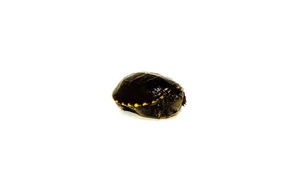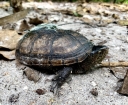Florida Mud Turtle (Kinosternon steindachneri)
Taxom: Although originally described as a species, K. steindachneri was long considered a subspecies of the eastern mud turtle (K. subrubrum|), but a 2013 analysis found there to be no data supporting this classification, and supported its recognition as its own distinct species. On November 11, 2020 Kinsternon subrubrum was split into Kinosternon suburubrum & Kinosternon steindachneri
Description: Florida mud turtles are an oval-shaped brown 4- to 5-inch turtle with a hinged plastron. They have a very thin bridge — the part that connects the top of the shell, carapace, to the bottom of the shell plastron — as compared to the common striped mud turtle.
Habitat: Mud turtles (genus Kinosternon) are fresh water turtles that are found in the Southeastern and Northeastern United States. They live in rivers, lakes and swamps. Mud turtles prefer ponds that have a lot of vegetation. These animals can generally be found in spring-fed streams, and they prefer clean, oxygenated water. In the wild, they also prefer sandy and muddy areas, as they will hibernate by burrowing into the mud. Mud turtles can tolerate brackish water so they may be found near salt marshes and on coastal islands.
Range: K. steindachneri is found in peninsular Florida. Its type locality is near Orlando.
Found in these States:
FL
Diet: The Florida Mud Turtle is omnivorous and feeds on insects, crustaceans, mollusks, amphibians, carrion, and aquatic vegetation. Smaller eastern mud turtles prey on small aquatic insects, algae, and carrion, whereas larger ones can feed on any type of food
Status: The main threat to these turtles is habitat loss and highway mortality, as few turtles manage to cross highways. Habitat loss via roads bisecting aquatic habitats, increased urbanization, and a change in climate that elevates sea levels all harm these mud turtles. Illegal pet trade of this species also has caused damage to their native ecosystem via loss of biodiversity.
»» Kingdom: Animalia - Animals
»» Phylum: Chordata - Chordates
»» Subphylum: Vertebrata - Vertebrates
»» Class: Reptilia - Reptiles
»» Order: Testudines - Turtles & Tortoises
»» Family: Kinosternidae - Mud & Musk Turtles
»» Genus: Kinosternon
»» Species: Kinosternon steindachneri - Florida Mud Turtle
»» Subspecies: None
This article uses material from the Wikipedia article "Florida Mud Turtle", which is released under the Creative Commons Attribution-Share-Alike License 3.0. Content may have been omitted from the original, but no content has been changed or extended.
|







